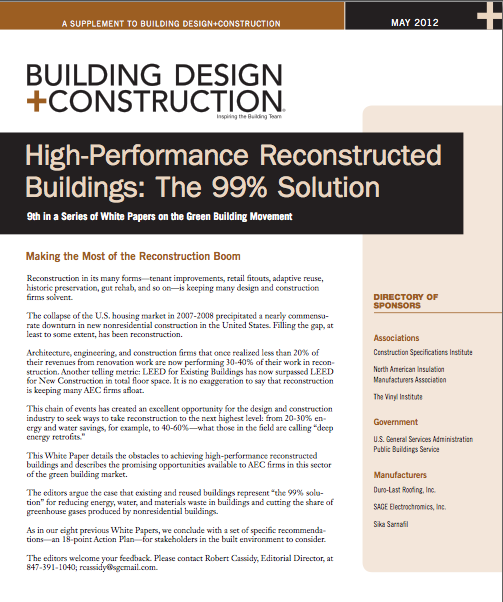Reconstruction in its many forms—tenant improvements, retail fitouts, adaptive reuse, historic preservation, gut rehab, and so on—is keeping many design and construction firms solvent.
The collapse of the U.S. housing market in 2007-2008 precipitated a nearly commensurate downturn in new nonresidential construction in the United States. Filling the gap, at least to some extent, has been reconstruction.
Architecture, engineering, and construction firms that once realized less than 20% of their revenues from renovation work are now performing 30-40% of their work in reconstruction. Another telling metric: LEED for Existing Buildings has now surpassed LEED for New Construction in total floor space. It is no exaggeration to say that reconstruction is keeping many AEC firms afloat.
This chain of events has created an excellent opportunity for the design and construction industry to seek ways to take reconstruction to the next highest level: from 20-30% energy and water savings, for example, to 40-60%—what those in the field are calling “deep energy retrofits.”
This White Paper details the obstacles to achieving high-performance reconstructed buildings and describes the promising opportunities available to AEC firms in this sector of the green building market.
The editors argue the case that existing and reused buildings represent “the 99% solution” for reducing energy, water, and materials waste in buildings and cutting the share of greenhouse gases produced by nonresidential buildings.
As in our eight previous White Papers, we conclude with a set of specific recommendations—an 18-point Action Plan—for stakeholders in the built environment to consider.
The editors welcome your feedback. Please contact Robert Cassidy, Editorial Director, at 847-391-1040; rcassidy@sgcmail.com.
Click here to download a PDF of High-Performance Reconstructed Buildings: The 99% Solution, the 9th in a Series of White Papers on the Green Building Movement
Chapter 1 Reconstruction: ‘The 99% Solution’ for Energy Savings in Buildings
Chapter 2 Exemplary High-Performance Reconstruction Projects
Chapter 3 How Building Technologies Contribute to Reconstruction Advances
Chapter 4 Business Case for High-Performance Reconstructed Buildings
Chapter 5 LEED-EB and Green Globes CIEB: Rating Sustainable Reconstruction
Chapter 6 Energy Codes + Reconstructed Buildings: 2012 and Beyond
Chapter 7 When Modern Becomes Historic: Preserving the Modernist Building Envelope
Chapter 8 High-Performance Reconstruction and Historic Preservation: Conflict and Opportunity
Chapter 9 The Key to Commissioning That Works? It Never Stops
Chapter 10 Action Plan: 18 Recommendations for Advancing Sustainability in Reconstructed Buildings
DIRECTORY OF SPONSORS
Associations
Construction Specifications Institute
North American Insulation Manufacturers Association
The Vinyl Institute
Government
U.S. General Services Administration Public Buildings Service
Manufacturers
Duro-Last Roofing, Inc.
SAGE Electrochromics, Inc.
Sika Sarnafil
Related Stories
Urban Planning | Apr 12, 2024
Popular Denver e-bike voucher program aids carbon reduction goals
Denver’s e-bike voucher program that helps citizens pay for e-bikes, a component of the city’s carbon reduction plan, has proven extremely popular with residents. Earlier this year, Denver’s effort to get residents to swap some motor vehicle trips for bike trips ran out of vouchers in less than 10 minutes after the program opened to online applications.
Laboratories | Apr 12, 2024
Life science construction completions will peak this year, then drop off substantially
There will be a record amount of construction completions in the U.S. life science market in 2024, followed by a dramatic drop in 2025, according to CBRE. In 2024, 21.3 million sf of life science space will be completed in the 13 largest U.S. markets. That’s up from 13.9 million sf last year and 5.6 million sf in 2022.
Multifamily Housing | Apr 12, 2024
Habitat starts leasing Cassidy on Canal, a new luxury rental high-rise in Chicago
New 33-story Class A rental tower, designed by SCB, will offer 343 rental units.
Student Housing | Apr 12, 2024
Construction begins on Auburn University’s new first-year residence hall
The new first-year residence hall along Auburn University's Haley Concourse.
K-12 Schools | Apr 11, 2024
Eric Dinges named CEO of PBK
Eric Dinges named CEO of PBK Architects, Houston.
Construction Costs | Apr 11, 2024
Construction materials prices increase 0.4% in March 2024
Construction input prices increased 0.4% in March compared to the previous month, according to an Associated Builders and Contractors analysis of the U.S. Bureau of Labor Statistics’ Producer Price Index data released today. Nonresidential construction input prices also increased 0.4% for the month.
Healthcare Facilities | Apr 11, 2024
The just cause in behavioral health design: Make it right
NAC Architecture shares strategies for approaching behavioral health design collaboratively and thoughtfully, rather than simply applying a set of blanket rules.
K-12 Schools | Apr 10, 2024
A San Antonio school will provide early childhood education to a traditionally under-resourced region
In San Antonio, Pre-K 4 SA, which provides preschool for 3- and 4-year-olds, and HOLT Group, which owns industrial and other companies, recently broke ground on an early childhood education: the South Education Center.
University Buildings | Apr 10, 2024
Columbia University to begin construction on New York City’s first all-electric academic research building
Columbia University will soon begin construction on New York City’s first all-electric academic research building. Designed by Kohn Pedersen Fox (KPF), the 80,700-sf building for the university’s Vagelos College of Physicians and Surgeons will provide eight floors of biomedical research and lab facilities as well as symposium and community engagement spaces.
K-12 Schools | Apr 10, 2024
Surprise, surprise: Students excel in modernized K-12 school buildings
Too many of the nation’s school districts are having to make it work with less-than-ideal educational facilities. But at what cost to student performance and staff satisfaction?

















